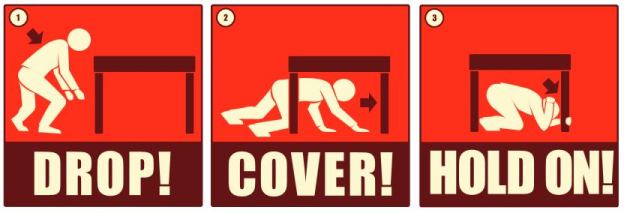
Worldwide, millions of people will practice how to Drop, Cover, and Hold On at 10:20 a.m. on October 20, 2016, during The Great California ShakeOut. Participating in the annual event is a great way to make sure you are prepared to survive and recover quickly from substantial earthquakes – whether you are at home, at work or traveling.
To help mark the occasion and call attention to earthquake preparedness, we want to take this opportunity to educate our subscribers and friends about earthquake preparedness in high-rise buildings. We would like to extend our thanks to Safe-T-Proof, which provided their “Quake Cottage” for a Pre-Great California ShakeOut event. They offer superior earthquake fasteners and straps for offices as well as survival kits and additional earthquake-safety supplies.Despite how odd it feels to stand in a tall building that sways during an earthquake, modern California high-rises provide safer refuge during earthquakes than most low-rise facilities. This is because architectural plans and construction for high-rise California structures built after the Sylmar quake in 1971 are required to follow stringent seismic codes. You can further improve your high-rise earthquake survival odds by taking preparedness steps.
Safety Tips for High-Rise Earthquakes
-
Stay put. Sitting down under a desk or doorway is the safest way to “ride out” a quake while it’s happening. Most earthquakes are relatively short. So it is safer to patiently wait a quake out instead of trying to exit the building as it moves.
-
Stay alert. If you have to exit a building, which is not recommended, you should move under cover in order to avoid falling debris such as panes of glass. Also, pay attention to warnings of fires or tsunamis which can follow any quake.
-
Stay informed. Tenants in high rises should be familiar with evacuation protocols for their building. A speedy yet orderly evacuation is crucial for ensuring building occupant safety. The National Fire Protection Association offers an evacuation plan video that encourages individuals to take ownership of their safety while following safety procedures.
Here are some earthquake safety tips for anyone who may not be in a high-rise to follow:
Indoors
-
Drop to the ground. Take cover by getting under a sturdy table and hold on. Stay inside until the shaking stops.
-
Stay away from glass or anything that can fall, like light fixtures and furniture.
-
Stay in bed if you are there when the earthquake strikes.
In a Fire…R-A-C-E to Safety!
-
Rescue—Remove any employees or visitors from immediate danger.
-
Alarm—Pull the nearest Fire Alarm and call the proper emergency phone number.
-
Contain—Contain all smoke and toxic fumes by closing all doors and windows.
-
Extinguish and Evacuate—Follow all posted and verbal procedures.
Outdoors
-
Stay where you are if you are not near any buildings, streetlights or utility wires.
-
Do not move from the area you are in until the shaking stops. Remember that aftershocks can be just as bad as the earthquake itself.
In a Moving Vehicle
-
Stop as quickly as possible, but stay in the vehicle. Avoid stopping near or under buildings, trees, overpasses and utility wires.
-
Proceed cautiously once the shaking has stopped. Avoid roads, bridges, or ramps that have been damaged.
Remember that safety is a daily priority for everyone, not only those working or living in high-rise buildings. For more information about the best Fire/Life Safety system out there, or to subscribe, click here.
 About the Author
About the Author
Kimber Westmore is the director of Allied Universal’s Fire Life Safety Training Division.























